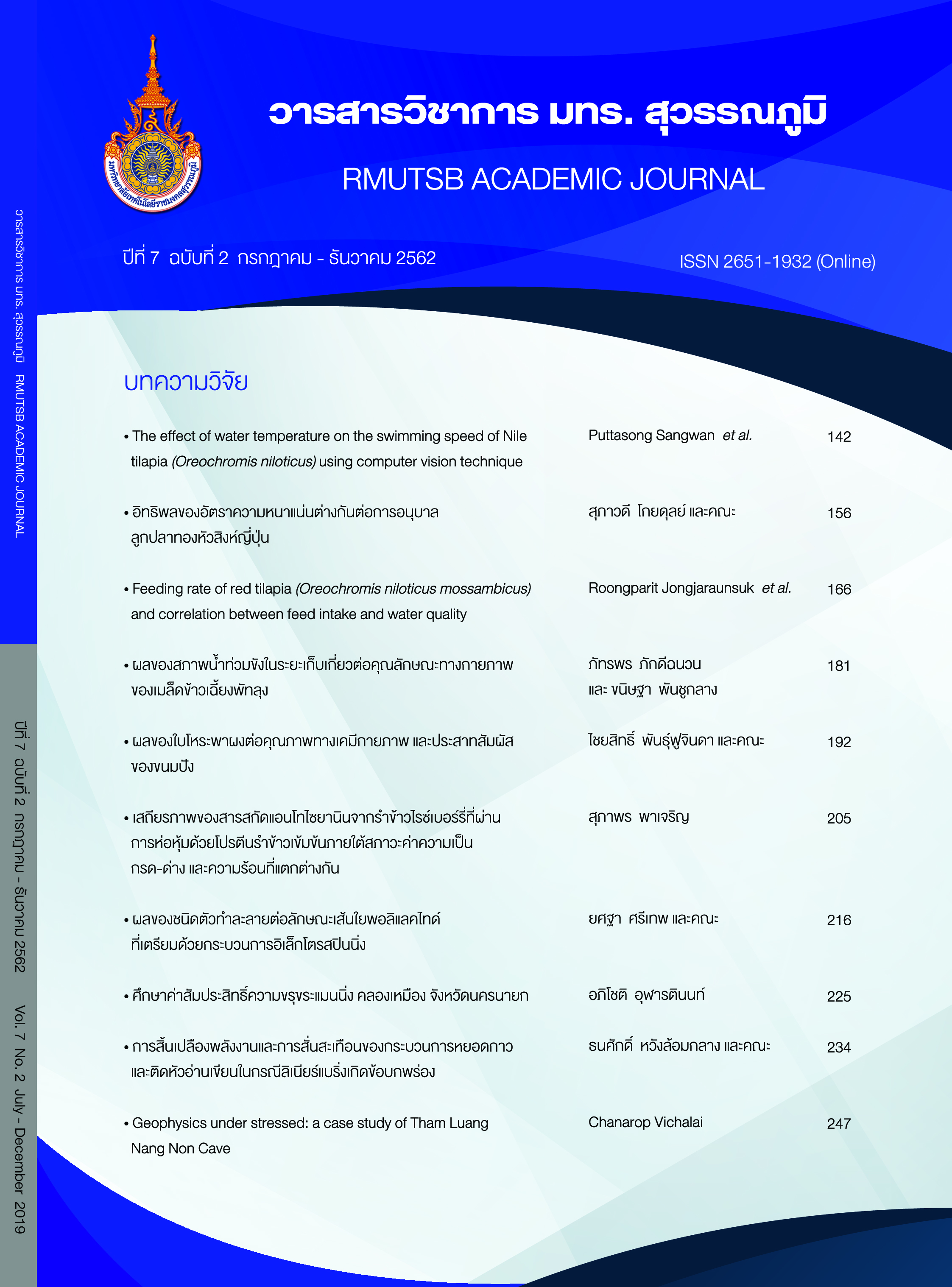Effects of waterlogging at harvesting stage on physical quality of Chiang Phatthalung rice (Oryza sativa L.) seeds
Main Article Content
Abstract
The objective of this study was to evaluate the effects of waterlogging at harvesting stage on physical qualities of Chiang Phatthalung rice seeds. A factorial 3×4 in completely randomized design was used with 4 replications. The first factor comprised with three conditions of waterlogging at different submergence depths of rice spike, no waterlogging (control), half submerged spike length, and fully submerged spike length. The other factor consists of different sun drying durations as follow; non-drying, sun drying for 1 day, sun drying for 3 days and sun drying for 5 days. The results revealed that the levels of waterlogging and the sun drying durations resulted in a significant different in the percentage of grain moisture content (p<0.05). The seeds from fully submerged rice spike gave the high percentage of moisture content (40.55%). Followed by the seeds from half submerged spike length (27.94%) and the seed from no waterlogging (22.99%), respectively. The sun drying for 5 days showed that the seed from no waterlogging, the seed half submerged spike length and the seeds from fully submerged rice spike had moisture content with the value of 7.56, 7.66 and 7.95%, respectively. Significant interaction was obtained between the levels of waterlogging and the sun drying durations on the percentage of seed moisture content. Waterlogging at harvesting stage affected color of the paddy rice and the milled rice seeds as verified by L*, a* and b* values. It was found that both of the paddy rice and the milled rice seeds became darker with increasing submergence depth, as indicated by increasing L* value. The seeds from fully submerged rice spike caused grain chalkiness to increase. In addition, scanning electron microscope (SEM) analysis indicated that the waterlogging at harvesting stage affected the starch granule formation and the gap in starch structure.
Article Details
Published manuscript are the rights of their original owners and RMUTSB Academic Journal. The manuscript content belongs to the authors' idea, it is not the opinion of the journal's committee and not the responsibility of Rajamangala University of Technology Suvarnabhumi
References
Eklou, A. S., Ines, M. S., Francis, N., Moussa, S., Ayoni, A. O., Kayode, S., & Daniel, D. T. (2006). Comparative studies of drying methods on the seed quality of interspecific NERICA rice varieties (Oryza glaberrima x Oryza sativa) and their parents. J. African Journal of Biotechnology, 5(18), 1618-1624.
Hosoya, K. (2013). Analysis on the occurrence of Chalky rice grain taking into consideration all of the grains within a panicle. J. of Developments in Sustainable Agriculture, 8, 127-131.
Juliano, B. O. (1985). Rice bran. In Rice: Chemistry and Technology. St. Paul, MN: American Association of Cereal Chemists.
Kato, M., Hayakawa, Y., Hyodo, H., Ikoma, Y., & Yano, M. (2000). Wound-induced ethylene synthesis and expression and formation of 1-aminocylclopropane-1-carboxylate (ACC) synthase, ACC oxidase, phenylalamine and peroxidasein wouded mesocarp tissue of Cucurbita maxima. Plant Cell Physiol, 98, 440-447.
Lee, H. S., Hwang, W. H., Jeong, J. H., Ahn, S. H., Baek, J. H., Jeong, H. Y., Park, H. K., Ku, B. I., Yun, J. T., Lee, G. H., & Choi, K. J. (2019). Analysis of the distribution of assimilation products and the characteristics of transcriptomes in rice by submergence during the ripening stage. BMC Genomics, 20, 1-16.
Office of Agricultural Economics. (2016). Attached the flooded area in Sathing Phra Peninsula. Received 23 February 2016, from https://www.oae.go.th/view/
Panomjan, N., Jandum, S., & Petkaew, W. (2561). Grain quality characteristics and structure of opaque and translucent endosperm in Sang Yod rice variety. J. Thaksin University, 21(3), 82-90.
Rice department. (2010). The rice seed production (2nd ed.). Bangkok: The Agricultural Co-operative Federation of Thailand.
Sumangala, K. Patil, M. B., Nargund, V. B., & Ramegowda, G. (2009). Effect of grain discolouration on quality parameters in rice. Journal of Plant Disease Science, 4(1), 33-37.
Yingyong, S., Arayarangsan, L., & Chotcheun, S. (2017). Top Thai rice. Received 10 May 2017, from https://www.toyota.co.th/
Zakaria, S., Matsuda, T., & Nitta, Y. (2000). Morphological studies on the mobilization of reserves in germinating rice seed. Plant Prod. Sci. 3(2), 152-160.
Zhou, Q., Huang, M., Huang, X., Liu, J., Wang, X., Cai, J., Dai, T., Cao, W., & Jiang, D. (2018). Effect of post-anthesis waterlogging on biosynthesis and granule size distribution of starch in wheat grains. Plant Physiology and Biochemistry, 132, 222-228.


